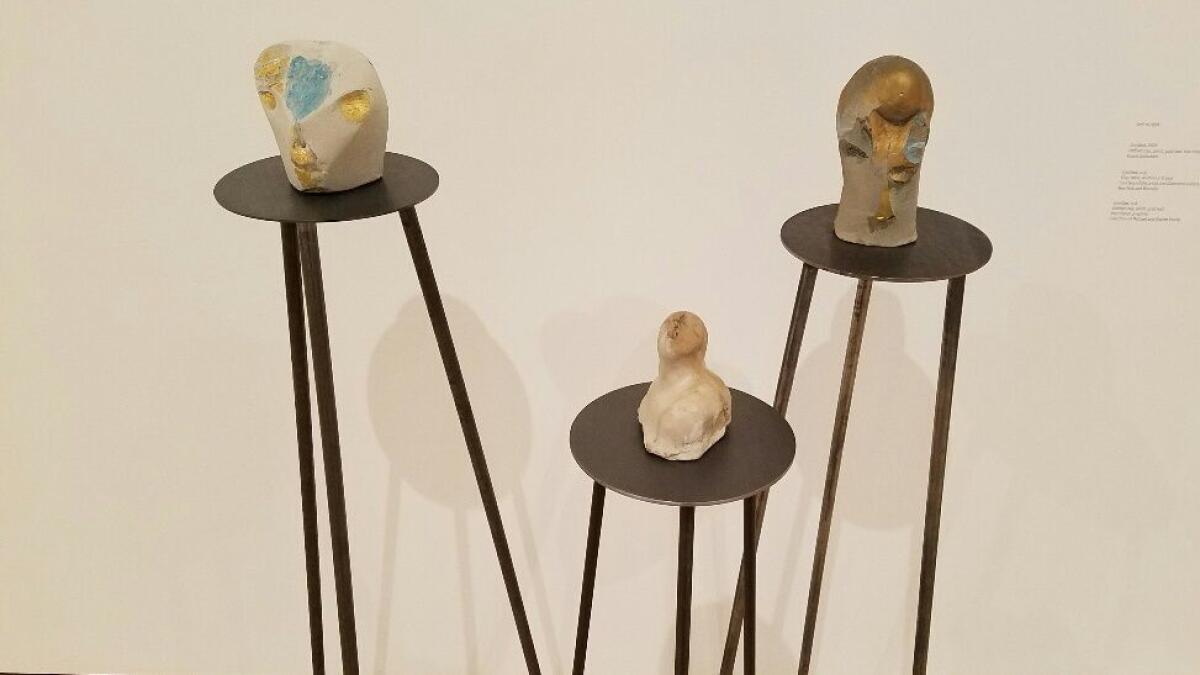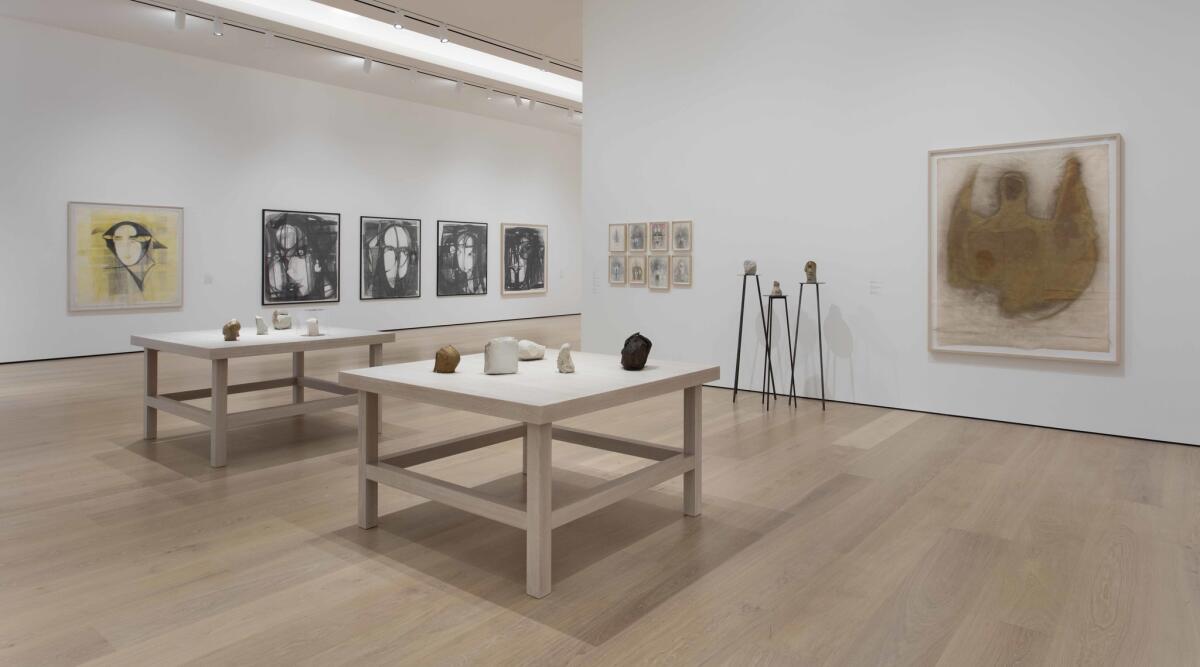Review: Marisa Merz retrospective at the Hammer gives an overlooked female artist her due

When you think of Italy and food, do canned peas immediately spring to mind?
Probably not. Which is one reason why a short film by Italian artist Marisa Merz at the start of her retrospective exhibition at the UCLA Hammer Museum is so beguiling.
Merz set up lights and a stationary camera in the kitchen of her apartment in Turin, the prosperous industrial and commercial center tucked into the country’s northwest corner. The 1967 film, given a slightly overexposed black-and-white palette and cheerfully amateur main performance, is a gentle sendup of classic Italian Neorealist films of the prior generation.
The artist is seated at a cluttered kitchen table, unartfully composed as a casual still life with bowls, vessels of olive oil and wine, a pitcher and other common paraphernalia. Merz, twisting a can opener to pop the top, pours off the liquid and begins removing the contents, one by one, placing each little pea onto a plate with focused care.
Her lips move with silent deliberation. Merz is “Counting,” as the film is titled, with each canned pea regarded as if a pearl to be soberly acknowledged and accounted for. (Canned peas, absurdist treasure!) The totting up scenario doesn’t so much end as simply unravel in a sudden burst of white film leader.
Neither is the artist just goofing on the glories of postwar Italian cinema with this brief if ponderous scene (it runs two minutes and 44 seconds), although it is certainly that. Merz is also lampooning Minimalism — ABC Art, as it was then sometimes called — the American import championed by Italy’s lone major collector of contemporary painting and sculpture, Giuseppe Panza di Biumo. Rigorous Minimalist order, with its geometric and industrial framework, is wittily characterized as culture in a can.
Transferred to video for the Hammer’s retrospective, the sometimes fluttery 16-millimeter film has apparently not been shown for 50 years — which is to say, not since it was made. That’s quite something, not least because the short film stands as the most concentrated exposition of Arte Povera aesthetics that I have ever seen.
On the other hand, its obscurity succinctly reflects the semi-oblivion to which the artist, the only woman among a dozen related Italian sculptors — including her prominent husband, Mario Merz — has generally been relegated. (Playing catch-up, the Venice Biennale awarded her the 2013 Golden Lion for Lifetime Achievement.) Merz is sort of like one of those canned peas, culturally hemmed in to a modern domestic routine; her distinctive importance as an artist is in how she embraced that seemingly confined context as integral to her work. Limitation became liberation.
Arte Povera — "poor art" or "impoverished art" — was a movement encompassing the work of a group of mutually supportive sculptors in the 1960s. They reacted against two things: the dominance of Modern painting in the artistic spotlight, and the juggernaut of industrial technology in daily life.
In some respects, Arte Povera followed on the heels of slightly earlier assemblage art in postwar California, which was driven by similar impulses. Forget exquisitely carved marble and expertly cast bronze; throw-away materials like rags, rope, clothing, rocks and found objects, often the trash left behind by exploding commercial culture, grabbed center stage.
Merz, daughter of a worker in the local Fiat factory, was born in 1926. Still at work in Turin at age 90, she has remained tight-lipped about the goings-on in the first third of her life. Hammer curator Connie Butler and Ian Alteveer, a curator at New York’s Metropolitan Museum of Art, where the show was seen earlier this year, suggest that refusing to articulate biographical details is one way in which Merz pointedly distinguishes her artistic practice from established norms.
They’ve got a point. Rather than the “great man” theory of history, Merz instead ties her work as an artist to the unfolding of her maternal domestic life. She begins her biography in 1960, the year her daughter Beatrice was born.
Hanging next to “Counting” at the show’s entry is a big, clunky plywood triangle suspended by straps from the ceiling — essentially a homemade swing. She made the pseudo-Minimalist sculpture as a toy for her child, who seems to have been the inspiration for some of the show’s most engaging works.
Among them are a group of other big suspended sculptures, their duct-like forms cobbled together from snipped aluminum sheeting held together by staples. Merz calls them “Living Sculptures.” Rather than industrial motifs, the materials are transformed into a homespun dollhouse, a child’s chair and vaguely figurative forms suggesting giant rag dolls and gargantuan puppets.
One is spray-painted with Warhol-style flowers, paintings that had caused a stir when shown in Paris the year before, colorfully cloaking her manufacturing material within a Pop bouquet of blossoms. The largest suspended sculpture goes back to nature piled atop the kitchen table — a cluster of abstract shapes that recall a mound of wild mushrooms.
More modest but equally affecting are sculptures painstakingly knitted from copper wire. Simple, potholder-like squares are arranged in checkerboard designs affixed to the wall, the pattern recalling her traditionally tiled kitchen.
In another woven work, the fluffy, glinting letters of her daughter’s name, “Bea,” are pierced by wooden knitting needles. The wall relief is like the arrow-riddled body of St. Sebastian in a Renaissance painting hanging in Turin’s celebrated royal collections from the House of Savoy.


Merz often refers to earlier art, especially Italian, in her work. Since the mid-1970s she has made chunky sculptures of burnished heads, often in unfired clay and sometimes daubed with paint or flecked with gold leaf. Shown singly or clustered on table tops, the severed forms are less Brancusi than Bronze Age.
Fragile, votive-like and smaller than lifesize, they’re crossed with the proto-Modern style of veiled, melting sculptural heads of Medardo Rosso, the celebrated 19th century Turin native. Chronological time collapses in these lovely works, the ancient fused with the contemporary.
A modern idea of progress — of counting, one might say, to arrive at a destination — gives way to synchronicity. I’m reminded that Turin was a center of the Risorgimento, the liberal 19th century move toward historic unification of a fractured and quarrelsome countryside that has since attained mythic status in Italy’s national consciousness.
Early on, Merz stopped dating the paintings, drawings and sculptures she makes. Most object labels in “Marisa Merz: The Sky Is a Great Space” offer a range — say, 1987 to 1994 — or else simply declare “no date.” The work seems to proliferate laterally, rather than building sequentially.
That’s a disconcerting effect for a museum retrospective, charged with organizing history. The surprising result is an intensely personal art that feels at once intimate and vast.
♦ ♦ ♦ ♦ ♦ ♦ ♦ ♦ ♦ ♦
‘Marisa Merz: The Sky Is a Great Space’
Where: UCLA Hammer Museum, 10899 Wilshire Blvd., Westwood
Information: Through Aug. 20; closed Mondays
Information: (310) 443-7000, www.hammer.ucla.edu
christopher.knight@latimes.com
Twitter: @KnightLAT
MORE ART REVIEWS AND NEWS:
It's not what it seems: Unraveling the secrets of Analia Saban's 'Threadbare'
Why Star Montana wants you to really see Boyle Heights through her stark and stirring portraits
His art centers on African American actors whose film titles 'Fade to Black'
Dennis Hopper's 'Lost Album' is an intimate photo diary of the ground-breaking 1960s
The biggest entertainment stories
Get our big stories about Hollywood, film, television, music, arts, culture and more right in your inbox as soon as they publish.
You may occasionally receive promotional content from the Los Angeles Times.








